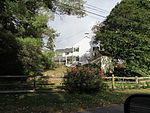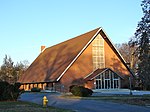Head of Christiana Presbyterian Church
19th-century Presbyterian church buildings in the United StatesBuildings and structures in Newark, DelawareChurches completed in 1859Churches in New Castle County, DelawareChurches on the National Register of Historic Places in Delaware ... and 4 more
Irish-American culture in DelawareNational Register of Historic Places in New Castle County, DelawarePresbyterian churches in DelawareScotch-Irish American history

Head of Christiana Presbyterian Church is a historic Presbyterian church and cemetery at 1100 Church Road in Newark, Delaware. It was built in 1859 and is a one-story, four bay gable roofed brick building. Adjacent to the church is a four and a half acre church cemetery with burials dating back to the mid-18th century. The church congregation was established in 1708 by Scotch-Irish immigrants.It was added to the National Register of Historic Places in 1983.
Excerpt from the Wikipedia article Head of Christiana Presbyterian Church (License: CC BY-SA 3.0, Authors, Images).Head of Christiana Presbyterian Church
West Church Road, Newark
Geographical coordinates (GPS) Address Nearby Places Show on map
Geographical coordinates (GPS)
| Latitude | Longitude |
|---|---|
| N 39.691944444444 ° | E -75.786666666667 ° |
Address
West Church Road
19711 Newark
Delaware, United States
Open on Google Maps









